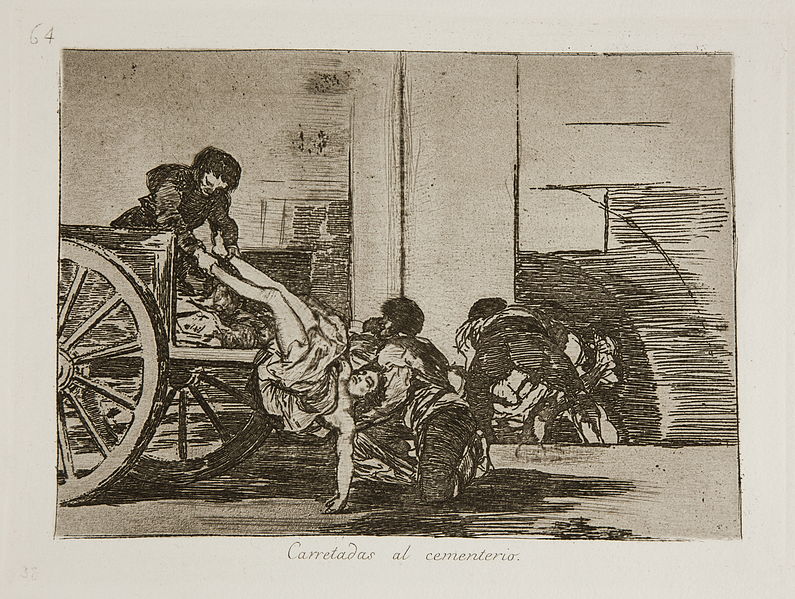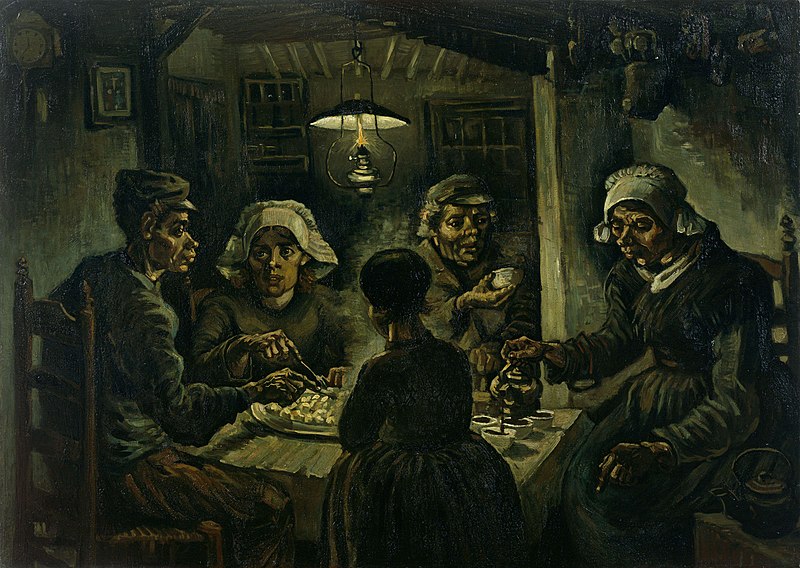 |
| Goya's Carretadas al cementerio |
One needs to only read Hemingway to see the influence of visual art on his writing. The Metropolitan Museum of Art has an article on Francisco Goya's looming presence in For Whom the Bell Tolls (1940). Specifically, Goya's The Disasters of War series can be seen. This series can be seen more directly, though, in Hemingway's short story "A Natural History of the Dead" from Winner Take Nothing (1933). The story describes, in gruesome detail, the ravages of war with mutilated corpses of humans and animals strewn across the fields decaying in the sun. Describing the sight of dead mules, the narrator says, "The numbers of broken-legged mules and horses drowning in the shallow water called for a Goya to depict them" (98). Later in the story, as a doctor examines a wounded patient, once in the daylight and once with a flashlight, the narrator intones, "That too would make a good etching for Goya, the visit with the flashlight, I mean" (103). Hemingway's descriptions of war in "A Natural History of the Dead," and in works such as A Farewell to Arms and For Whom the Bell Tolls, show the influence of artists like Goya who unapologetically displayed the ravages of war in his etchings.
Like Hemingway, Gaines draws inspiration from visual art. Later in the 1986 interview, Gaines explained, "Just look at paintings and see how you can describe a beautiful room with only two or three things, without having to go through everything in the room. Right now I'm thinking of Van Gogh's painting called 'Vincent's Room' [Bedroom in Arles]--it's a room where he used to live and sleep--and how he could do it so well with only two or three things or pieces of things" (207). Van Gogh painted three versions of Bedroom in Arles, each with slight variations. Reading through Gaines' work, as well as Hemingway's (look at "Homage to Switzerland"), repetition and sparseness play a role. Think about the dialogue of both authors or the repetition of phrases, stated in slightly different ways.
Elsewhere, in "Bloodline in Ink," Gaines states that Van Gogh attracted him more than Modigliani's nudes, in part because of Van Gogh's depiction of country and peasant life. "I like The Potato Eaters," Gaines says, "and the worker's shoes and the people sowing wheat in the field. All this reminded me of home--Van Gogh did, not Modigliani" (42). Just as Gaines' literary influences created vivid depictions of peasants, the visual artists that inspire Gaines do the same thing. In an 1885 letter, Van Gogh wrote about the painting, saying:
You see, I really have wanted to make it so that people get the idea that these folk, who are eating their potatoes by the light of their little lamp, have tilled the earth themselves with these hands they are putting in the dish, and so it speaks of manual labor and--that they have thus honestly earned their food. I wanted it to give the idea of a wholly different way of life from ours--civilized people. So I certainly don't want everyone just to admire it or approve of it without knowing why.
 |
| Van Gogh's The Potato Eaters |
Gaines, Ernest J. "Bloodline in Ink." Mozart and Leadbelly. Eds. Marcia Gaudet and Reggie Young. New York: Vintage, 2005. 37-44. Print.
Gaudet, Marcia and Carl Wooton. "An Interview with Ernest J. Gaines." Conversations with Ernest Gaines. Ed. John Lowe. Jackson: University of Mississippi Press, 1995. 200-216. Print.
Hemingway, Ernest. Winner Take Nothing. New York: Collier Books, 1986. Print.
No comments:
Post a Comment